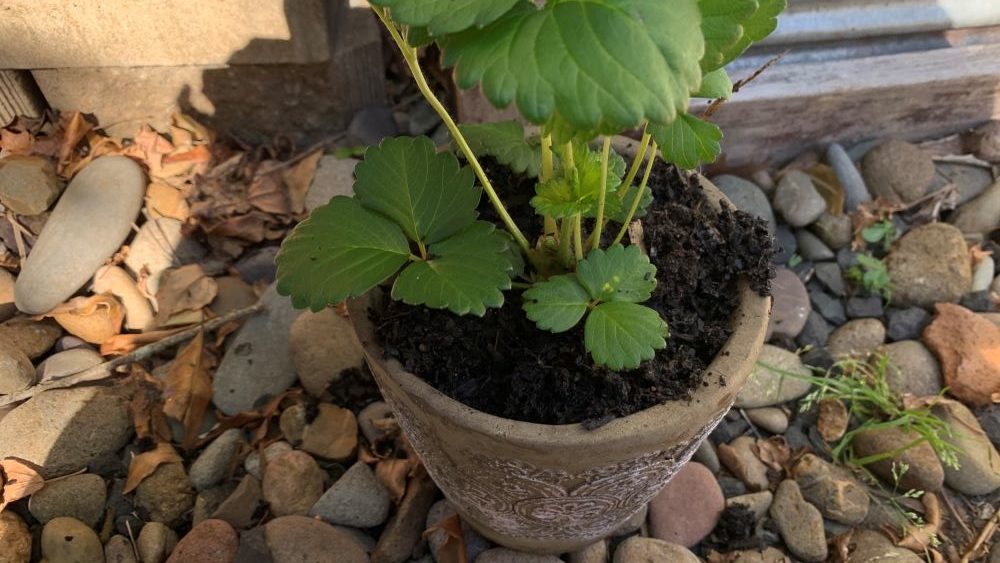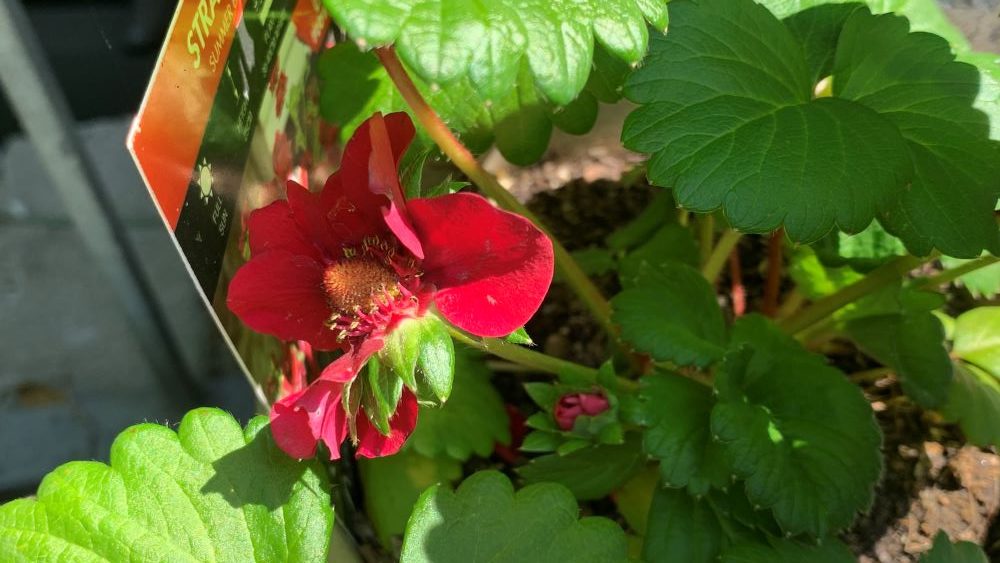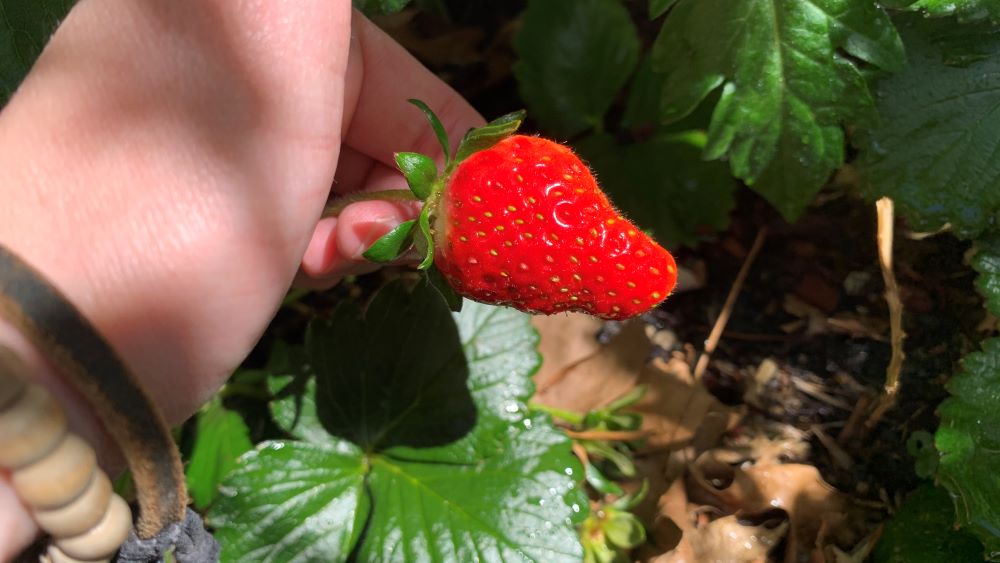Strawberries can become root bound in their pots if they are left for too long. They benefit from repotting as a root bound strawberry will quickly run out of nutrients, will struggle to absorb water and will suffer from brown leaves and may not set fruit. Transplanting root bound strawberries is easy and can save your plant.
This article will explore the signs that your strawberry may be root bound, how to safely transplant the strawberry plant and how long it takes for the plant to recover.

The signs of root bound strawberries
Here are the top things to look out for to figure out if your strawberry could be root bound.
- A pot that feels firm when you squeeze it
- Strawberry roots growing out of the pot drainage holes
- Browning leaves
- Fruit not setting
- Flowers not growing
- Stunted growth
- Water running quickly out the bottom of the pot when watered.
If you suspect your strawberry is root bound it is time to take action and repot the plant. When you gently remove the plant from its pot you will see roots winding around the bottom of the pot. Roots that are matted and tangled can struggle to absorb the water and nutrients the plant needs.
How to fix root bound strawberries
Once you have found out that your strawberries are root bound it can be time to repot them. These are my steps to repotting a root bound strawberry plant.
1. Trim off any old leaves and stems
Before transplanting your strawberry plant to a new pot or garden bed remove any old, brown leaves. Any leaves that have died back or are damaged can be trimmed off using clean secateurs.
2. Soak the plants in water and seaweed solution
A root bound, dry strawberry plant can be soaked in a bucket with water and a dash of seaweed solution. Submerge the plant and leave it for 5 minutes to take up water and get it ready to move.
2. Gently pull the plants apart
If multiple plants have become tangled together, gently pull them apart with your hands. Soaking should help to allow the plants to be pulled apart.
If the roots won’t come apart, you can use secateurs to snip through any that are severely tangled. You can also use a garden knife, or for me, that is an old kitchen knife that I have saved for this purpose.
3. Use good quality potting soil
Use a premium potting soil when transplanting strawberry plants or plant them in a prepared garden bed. Mix through compost, aged cow manure and lighten the soil with a spade or fork to mix it all through.

4. Water well with seaweed solution
Once the plant has been moved to its new pot and backfilled with premium potting soil or planted in a garden bed it is time to water well. Add some seaweed solution to your watering can to help the roots recover.

Will strawberries recover from being root bound
If you transplant the strawberries with minimal damage to the roots then they can survive being root bound. Strawberries will slow their growth in winter and burst back to life in spring so don’t expect too much to happen over this time.
If you transplant root bound strawberries in winter, wait until the weather warms and you should see new leaves start to appear.

How long it takes for strawberries to recover from being root bound
After you transplant strawberries into new potting soil or a new garden bed it can take around 4-6 weeks to see any sign of new growth. Doing this at the end of winter or start of spring is fantastic as the weather will start to warm soon and the plant will start to put on new growth.
If you manage to transplant strawberries before they set fruit they can recover quickly enough to grow berries in the next few weeks. Strawberries that already have stems for flowers or fruit can be trimmed off and the plant may send out new ones once it has recovered from the move.
You can remove the first flowers on a new strawberry plant to help it establish. For me, I left these on and my small, newer plants have grown 3-4 strawberries each in their first season.

Problems with root bound strawberries
Leaving strawberries root bound can cause problems. Here are the top signs that your strawberry is root bound and would benefit from repotting or planting out into a garden bed.
Browning leaves
While strawberry leaves can naturally die off and turn brown over the winter, browning during the growing season of spring and summer can be a sign that they are root bound. Root bound strawberries will struggle to absorb the water and nutrients they need to grow healthy green leaves.

Strawberries that become root bound in pots can fill out the base of the pot and quickly run out of soil. When the bottom of the pot is full of roots, the water can run straight through and dry out the plant.
Equally the plant will no longer have access to the range of nutrients it needs to grow well, which includes nitrogen.
Root bound strawberries suffering in this way will benefit from being repotting into a larger pot with new potting soil. Choose a pot that is 2 inches deeper than the pot it was in or plant it out into a garden bed with compost and aged cow manure mixed through.
Strawberries not forming
Another sign that your strawberries maybe root bound is that they will not form fruit. The plant may have enough energy to form a flower but may lack the nutrients or water to properly grow flowers and berries.
Strawberries need rich soil and regular water to grow fruit well and a plant that is root bound will usually not have either of these. If you strawberry plant has been in the same pot for 2 years or more it could be root bound and need to be moved before fruit will grow well.
Stunted growth
A strawberry plant that is struggling to grow new leaves or a healthy crown could be root bound. If you notice that your strawberry just isn’t growing any more in spring and summer then it could be time to repot the plant.
Once the roots of the strawberry reach the limits of the pot, they will start to wrap around each other and trail around the inside of the pot. This means that it time to move it out, find a new pot and plant it into some premium potting soil.
Trim off any old leaves and water it well for the first two weeks to settle the plant into its new home.
Do strawberries get root bound?
Strawberries can get root bound if they outgrow the pot that they are in. Some strawberries can outgrow a small pot within a year and need to be transplanted to avoid their roots running out of soil and water.
Repotting strawberries can be done during fall, winter or spring but the best time is late winter to early spring. This will give strawberries new room to grow and will prepare the plant before they are ready to grow new strawberry flowers and berries.

When should I repot my strawberries?
Repot strawberries when you feel that the pot is becoming firm or you start to see the roots escaping out of the bottom drainage holes. This usually happens within 2 years of planting a strawberry into a new pot.
A root bound strawberry will feel very firm when you squeeze the outside of the pot as the roots have grow large and entangled. It is best to repot a strawberry before it becomes root bound so its growth will not be slowed as it recovers.
Root bound strawberries | Summary
Strawberries can become root bound quickly if they are left in small pots. Be gentle with strawberry roots to help them to recover quickly. Strawberries are a hardy plant but will transplant better if there is minimal disturbance to their roots. Use good quality potting soil or improve your garden soil before transplanting the strawberries.
It can take a few weeks for the plants to recover but you should see new leaves and growth within a few weeks if this is done well.
Happy growing.
Strawberries
- Strawberry Companion Plants | Best Vegetables, Herbs + Flowers
- No fruit on strawberry plants | 9 Reasons Why
- Strawberries with pink flowers | Lipstick, Roseberry + Pink Panda
- Mulch strawberries with leaves | Tips and Tricks
- Mulching strawberries with wood chips | How to Guide
- Small Strawberries | + 5 Ways to grow them bigger
- Do strawberry plants need full sun? | Tips for sweet strawberries
- Strawberry plants and frost | Protecting your strawberries
- Can you plant strawberries and tomatoes together?
- Strawberry plants with red flowers | Grow Guide
- How to prune strawberry plants | Winter pruning guide
I am an accredited practicing dietitian, experienced gardener and a dedicated cook. I love writing and sharing my experience so you can learn from my successes and mistakes.
